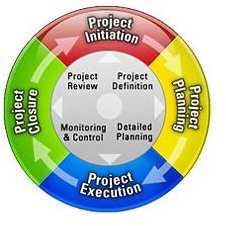Project Management Decisions: Critical Chain vs. Critical Path
Choosing a Path or a Chain
Critical chain management was developed by Eliyahu Goldratt. It was developed to contrast the popular critical path method and PERT. While these two methods focus on the order of the tasks and schedules, critical chain management allows tasks to be evenly distributed by focusing more on start times and the tasks themselves. A critical chain is defined the longest continual sequence of tasks that require resources.
You may have also heard of another methodology: critical path. The critical path is a way of scheduling all of the activities in your project. It is based on the modeling techniques created by James E. Kelly, Jr. of Remington Rand and Morgan R. Walker of DuPont. This methodology was first released in the 1950s. In fact, the techniques instituted by this type of methodology helped make the Manhattan Project a success.
So, now you are left with a decision: critical chain vs. critical path. Which methodology is more successful? Which one should you follow? The answers to these questions may seem difficult, but they are really not. You just need to figure out which one offers the best chance of success every time you need it.
But Why Critical Chain?
Critical chain cuts down on the extensive padding put on most tasks in regular project management. Critical chain starts at the end of
the project and works backward. Based on previous experiences, estimates can be made on each task to see how long it will take. Then, some space is added between projects to give some leeway on the estimates.
These estimates are based on best guess estimates and the probability of that task being done within that time frame. Then, the available resources are assigned to each task.
Critical chain focuses on cutting the buffers (time between tasks) down to 50 percent. This puts immediacy on the task at hand. It also cuts down on multitasking. If a task needs to be done before another task can be started, team members cannot jump between tasks.
Multitasking can be very detrimental to the overall project. Team members are stretched thin trying to work on three or four projects at once, basically ensuring that the overall project will not be done on time.
In most other methods, people are not rewarded for getting their task done early since other tasks needed for the critical path are still behind schedule. Critical chain eliminates this problem.
Since the buffers are cut by 50 percent, the method assumes that some projects will get done early while others will take longer. But, when one task is completed early, the next task can be started. This means the tasks that get done early and those that get done late, will average out and the project will be completed on time.
What is a Buffer?
The buffer is a quantity of time between tasks that ensures that the project will be completed on time and within budget. A buffer allows a project manager to see how well the overall project is progressing.
If most projects are getting done within the buffer zone, then the overall project should be on schedule. If, on the other hand, most projects are eating away at their buffer zones, this could be trouble. Corrective action needs to be taken immediately.
What is the Difference Between Critical Chain and Critical Path?
Critical chain focuses on the beginning and the end of the project while critical path focuses on the buffer. Critical chain gives project managers a bit more flexibility since they can see how the overall project is progressing based on how well the buffers are holding up. If you’re just focusing on the overall project, it may be too late before you realize that something is wrong.
Critical chain is just more successful than critical path. If used correctly, projects using critical chain are done on budget and on time 95 percent of the time. Since over 50 percent of projects are late or over-budget, critical chain is quite superior to its competitors.
Which Will You Choose?
You may still be faced with the question: critical chain vs. critical path. As mentioned earlier, critical chain is more successful, but you also can’t forget about the buffers in the project.
You still need to incorporate some aspects of critical path to have a successful project. Project management often involves using a variety of methodologies to be successful. In the long run, however, critical chain offers a better chance of success every time that you use it. You should, however, be prepared to tweak any methodology you use so that it fits your organization.
References
Focused Performance - Critical Change Frequently Asked Questions retrieved at https://www.focusedperformance.com/ccfaq.html
Image Credit:
